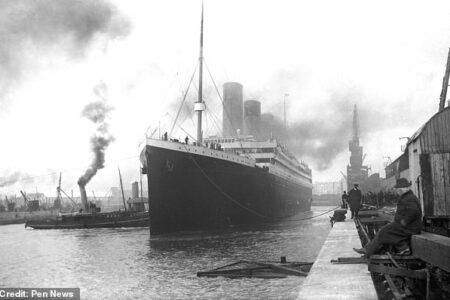A haunting letter written by a tragic teen aboard the Titanic is set to fetch tens of thousands of pounds at auction.
Aged just 16, Thomas Cupper Mudd from Huntingfield, Suffolk, was among the youngest of the 1,500 people lost in the Titanic sinking.
But his last letter to his mother survives, written on Titanic-branded paper and sent home from the vessel’s final port of call just three days before it hit an iceberg.
In the letter, he calls the liner a ‘magnificent palace’ but admits they’ve had ‘very rough weather’ and that ‘the ship is rolling a good bit’.
He wrote: ‘Dear Mother & all at home. I am now taking the opportunity of sending you a few lines about how we started from Southhampton [sic]…
‘We have been having very rough weather but the ship is so steady you would hardly know it was moving, was it not for the throbbing of the engines.
‘We are now nearing Queenstown.’
Queenstown in Ireland, today called Cobh, was the last place Titanic – which was on its maiden voyage and bound for New York – made landfall and was where Thomas’ letter was posted from.

A haunting letter written by a tragic teen aboard the Titanic is set to fetch tens of thousands of pounds at auction. Aged just 16, Thomas Cupper Mudd from Huntingfield, Suffolk, was among the youngest of the 1,500 people lost in the Titanic sinking
The letter, written on Titanic-branded paper, was sent home from the vessel’s final port of call just three days before it hit an iceberg
The teen continued: ‘The ship is like a magnificent palace. The lounge & dining hall are very beautiful. We are having excellent food.
‘I have made friends with a young English gentleman and he is very nice indeed.
‘The beds are very nice also with plenty of covering to keep warm also they have spring mattresses.’
He concluded: ‘Excuse writing as the ship is rolling a good bit. Now I must close.
‘With love to all. I remain, your loving son Tom.’
Rupert Powell of Forum Auctions, which is handling the sale of the letter, said it was ‘particularly poignant’.
He said: ‘Thomas Mudd perished in the sinking and his body, if recovered, was never identified.
‘At only 16, he was one of the youngest victims of the Titanic disaster, and so this letter is particularly poignant.
The Titanic hit an iceberg in the Atlantic ocean on April 14, 1912
Queenstown in Ireland, today called Cobh, was the last place Titanic – which was on its maiden voyage and bound for New York – made landfall and was where Thomas’ letter was posted from. Above: What is believed to be the last image of the Titanic, leaving Queenstown for New York
‘The letter is written on paper headed with the White Star Line burgee.’
He added: ‘When reading the letter today we thus feel hauntingly close to one of history’s greatest tragedies.’
Born in 1895, Mudd was one of 13 children of Thomas and Elizabeth Coe Mudd.
Two of his older siblings had already emigrated to America by 1912.
His brother James had left in 1907 for Radnor, Pennsylvania, where he took up work as a gardener, while brother George followed in 1911.
Thomas, a bookkeeper, was en-route to join them, purchasing a second-class ticket for £10 10s and sailing from Southampton on April 10, 1912.
He wrote his final letter the following day.
Mr Powell, deputy chairman and international head of books at Forum Auctions, said it was a ‘rare’ piece of history.
The letter, which is expected to fetch up to £30,000, will go under the hammer on March 27 at Forum Auctions in London
He said: ‘Sent by a young man to his mother in which he enthusiastically describes the opulence and magnificence of the Titanic, this letter is a rare first-hand testament to the awful tragedy which befell the ship a matter of days later.
‘Young Thomas Mudd was only 16 years old and looking forward to joining his two brothers to start a life in America when he perished.
‘This letter, posted from Queenstown, Ireland survived.’
After the disaster, Thomas’ parents received financial support from the Titanic relief fund.
His brothers in America, James and George, lived until 1953 and 1966 respectively, with the latter naming his first-born son Thomas.
The letter, which is expected to fetch up to £30,000, will go under the hammer on March 27 at Forum Auctions in London.


